Summary of C++ Review Key Points No. 9 - Inheritance 2
Method for handling member variables with the same name in inheritance
1. When the member variable of the subclass has the same name as the member variable of the parent class
2. The subclass still inherits the member with the same name from the parent class
3. Distinguish members with the same name in the subclass through the scope discriminator:: (use members of the base class with the same name in the derived class and explicitly use the class name qualifier)
4 , members with the same name are stored in different locations in memory
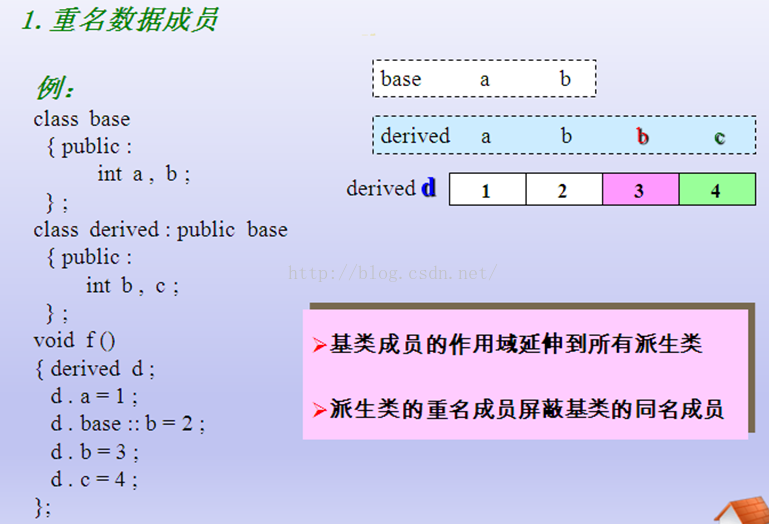
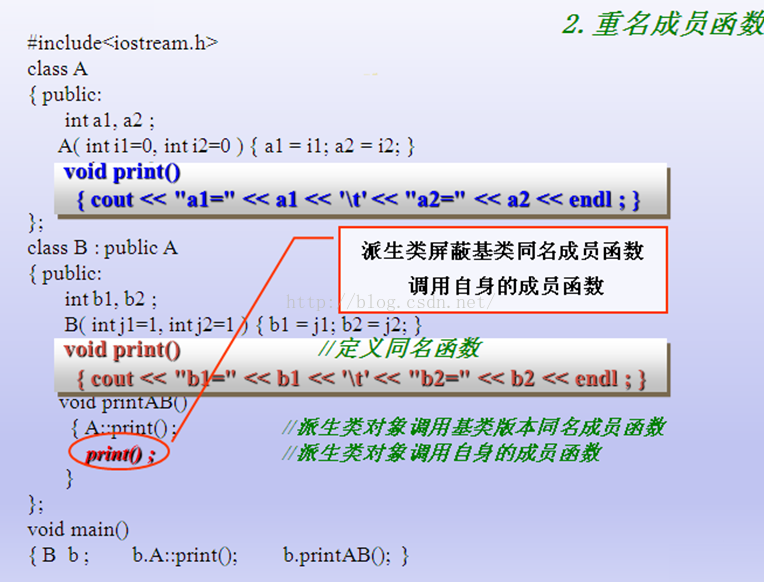
2. The static keyword in derived classes
Inheritance What will happen if it is combined with the static keyword?
Theoretical knowledge
Ø Static members defined by the base class will be shared by all derived classes
Ø According to the access characteristics of the static members themselves and the inheritance method of the derived class, in There are different access properties in the class hierarchy (comply with the access control of derived classes)
Ø To access static members in a derived class, use the following form to explicitly state:
Class name:: member
Or access the object name through the object. Members



1> Static functions also comply with the three access principles
2> Static is easy to make mistakes (not only must it be initialized, but more importantly, it must explicitly tell the compiler to allocate memory)
3> The constructor defaults to private
Concept of multiple inheritance
Ø The inheritance relationship in which a class has multiple direct base classes is called multiple inheritance
Ø Multiple inheritance declaration syntax
class Derived class name: access control base class name 1, access control base class name 2, …, access control base class name n
{
Data member and member function declaration
};
Ø Class C can inherit members of class A and class B at the same time based on access control, and add
its own members
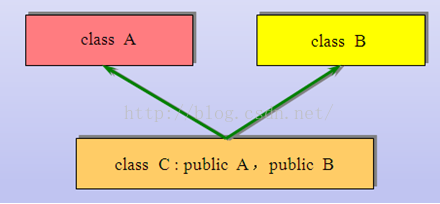
Ø The derived class constructor of multiple base classes can use the initializer to call the base class constructor to initialize the data members
Ø Execution The order is similar to the case of single inheritance constructors. The order in which multiple direct base class constructors are executed depends on the order in which each inherited base class is specified when defining the derived class.
ØA derived class object has multiple direct or indirect base class members. There will be no ambiguity when accessing members with different names. If different base classes have members with the same name, they should be identified when accessing derived class objects.
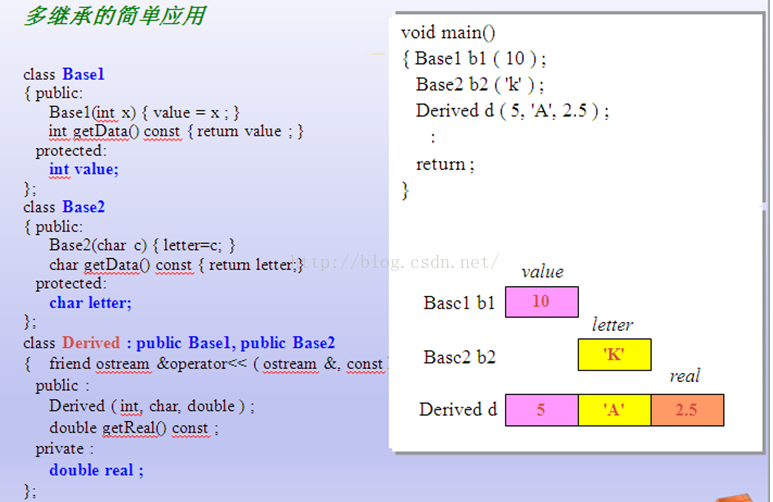

If a derived class is derived from multiple base classes, and these base classes have A common base class, then ambiguity may occur when accessing the name declared in the base class
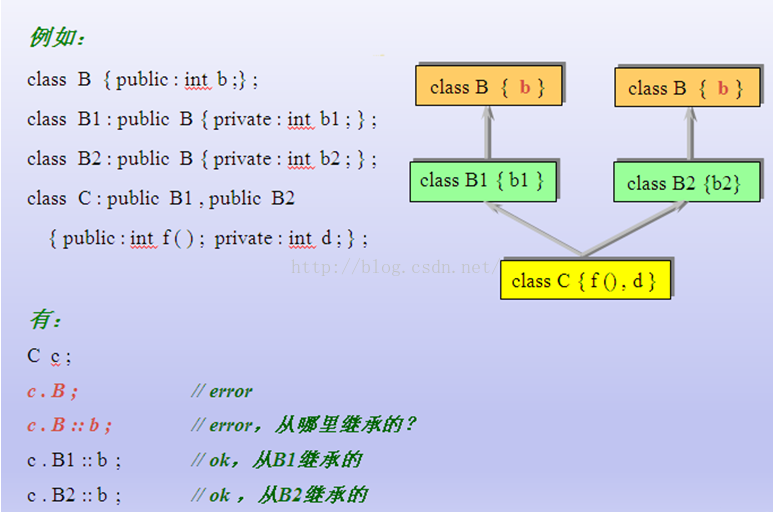 ## Analysis:
## Analysis:
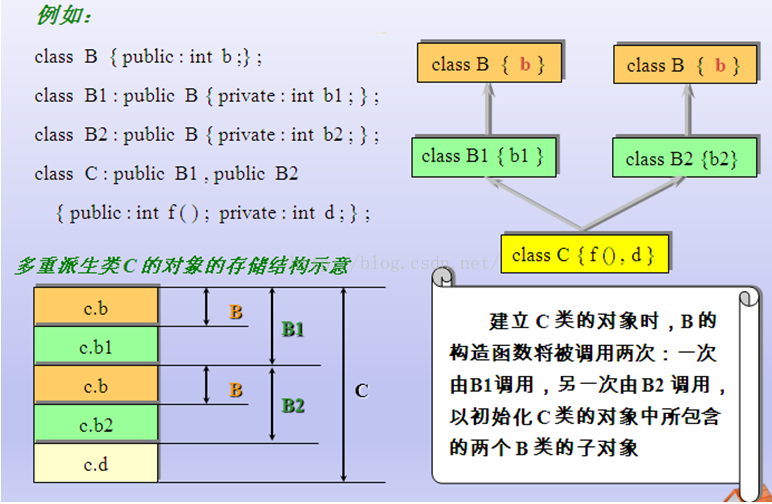 Summary:
Summary:
Ø If a derived class is derived from multiple base classes, and these base classes have a common base class, then the base class When the name declared in the class is accessed,
ambiguity may occur
Ø If there is a common base class on multiple inheritance paths, then somewhere in the inheritance path
Convergence point, this public base class will generate multiple base class sub-objects in the object of the derived class
Ø To make this public base class generate only one sub-object in the derived class, you must Declare this base class as virtual inheritance, making this base class a virtual base class.
Ø Virtual inheritance declaration uses the keyword virtual
Experiment: Note that after adding the virtual keyword, the constructor is called number of times.
3 Inheritance Summary
Ø Inheritance is an important method for realizing software reuse in object-oriented programming. Programmers can define new derived classes based on existing base classes.
Ø A derived class with single inheritance has only one base class. A derived class with multiple inheritance has multiple base classes.
Ø The access of derived classes to base class members is determined by the inheritance method and member properties.
Ø When creating a derived class object, first call the base class constructor to initialize the base class members in the derived class. The order in which destructors are called is the reverse of the order in which constructors are called.
Ø C++ provides a virtual inheritance mechanism to prevent ambiguity in member access in class inheritance relationships.
Ø Multiple inheritance provides powerful functions of software reuse, but also increases the complexity of the program.
The above is the summary of the ninth point of C++ review - Inheritance 2. For more related content, please pay attention to the PHP Chinese website (www.php.cn)!

Hot AI Tools

Undresser.AI Undress
AI-powered app for creating realistic nude photos

AI Clothes Remover
Online AI tool for removing clothes from photos.

Undress AI Tool
Undress images for free

Clothoff.io
AI clothes remover

AI Hentai Generator
Generate AI Hentai for free.

Hot Article

Hot Tools

Notepad++7.3.1
Easy-to-use and free code editor

SublimeText3 Chinese version
Chinese version, very easy to use

Zend Studio 13.0.1
Powerful PHP integrated development environment

Dreamweaver CS6
Visual web development tools

SublimeText3 Mac version
God-level code editing software (SublimeText3)

Hot Topics
 1359
1359
 52
52
 How to implement the Strategy Design Pattern in C++?
Jun 06, 2024 pm 04:16 PM
How to implement the Strategy Design Pattern in C++?
Jun 06, 2024 pm 04:16 PM
The steps to implement the strategy pattern in C++ are as follows: define the strategy interface and declare the methods that need to be executed. Create specific strategy classes, implement the interface respectively and provide different algorithms. Use a context class to hold a reference to a concrete strategy class and perform operations through it.
 Similarities and Differences between Golang and C++
Jun 05, 2024 pm 06:12 PM
Similarities and Differences between Golang and C++
Jun 05, 2024 pm 06:12 PM
Golang and C++ are garbage collected and manual memory management programming languages respectively, with different syntax and type systems. Golang implements concurrent programming through Goroutine, and C++ implements it through threads. Golang memory management is simple, and C++ has stronger performance. In practical cases, Golang code is simpler and C++ has obvious performance advantages.
 How to implement nested exception handling in C++?
Jun 05, 2024 pm 09:15 PM
How to implement nested exception handling in C++?
Jun 05, 2024 pm 09:15 PM
Nested exception handling is implemented in C++ through nested try-catch blocks, allowing new exceptions to be raised within the exception handler. The nested try-catch steps are as follows: 1. The outer try-catch block handles all exceptions, including those thrown by the inner exception handler. 2. The inner try-catch block handles specific types of exceptions, and if an out-of-scope exception occurs, control is given to the external exception handler.
 How to iterate over a C++ STL container?
Jun 05, 2024 pm 06:29 PM
How to iterate over a C++ STL container?
Jun 05, 2024 pm 06:29 PM
To iterate over an STL container, you can use the container's begin() and end() functions to get the iterator range: Vector: Use a for loop to iterate over the iterator range. Linked list: Use the next() member function to traverse the elements of the linked list. Mapping: Get the key-value iterator and use a for loop to traverse it.
 How to use C++ template inheritance?
Jun 06, 2024 am 10:33 AM
How to use C++ template inheritance?
Jun 06, 2024 am 10:33 AM
C++ template inheritance allows template-derived classes to reuse the code and functionality of the base class template, which is suitable for creating classes with the same core logic but different specific behaviors. The template inheritance syntax is: templateclassDerived:publicBase{}. Example: templateclassBase{};templateclassDerived:publicBase{};. Practical case: Created the derived class Derived, inherited the counting function of the base class Base, and added the printCount method to print the current count.
 What are the common applications of C++ templates in actual development?
Jun 05, 2024 pm 05:09 PM
What are the common applications of C++ templates in actual development?
Jun 05, 2024 pm 05:09 PM
C++ templates are widely used in actual development, including container class templates, algorithm templates, generic function templates and metaprogramming templates. For example, a generic sorting algorithm can sort arrays of different types of data.
 How to access elements in C++ STL container?
Jun 05, 2024 pm 06:04 PM
How to access elements in C++ STL container?
Jun 05, 2024 pm 06:04 PM
How to access elements in C++ STL container? There are several ways to do this: Traverse a container: Use an iterator Range-based for loop to access specific elements: Use an index (subscript operator []) Use a key (std::map or std::unordered_map)
 Why does an error occur when installing an extension using PECL in a Docker environment? How to solve it?
Apr 01, 2025 pm 03:06 PM
Why does an error occur when installing an extension using PECL in a Docker environment? How to solve it?
Apr 01, 2025 pm 03:06 PM
Causes and solutions for errors when using PECL to install extensions in Docker environment When using Docker environment, we often encounter some headaches...





